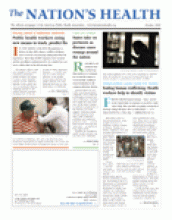The kitchen might be the proverbial heart of the home, but some Americans need to do a better job keeping theirs clean. If home kitchens were held to the same standards as restaurants, at least one in seven would fail to pass a routine health inspection, a new study has found.
The study, published Sept. 3 in Morbidity and Mortality Weekly Report and based on the results of an online quiz taken by about 13,000 Los Angeles area adults, found that only 34 percent of respondents would receive a grade of “A” if their home kitchens were inspected similarly to restaurants. About 27 percent would earn grades of “B,” 25 percent would get a “C” and 14 percent would score below 70 percent.
By contrast, about 98 percent of Los Angeles County restaurants received “A” or “B” ratings during the same 2006-2008 time frame, the study authors noted.
“Foodborne diseases remain an important cause of morbidity in the United States among all age groups,” the study authors said. “A potentially important contributor to this morbidity is improper food handling and preparation practices in kitchens at restaurants and in private homes.”
The online quiz was part of the Los Angeles County Department of Public Health’s home kitchen self-inspection and education program. Launched in 2006 to promote safer food hygiene practices at home, the program includes an Internet-based food safety quiz that asks respondents about their food handling and preparation practices at home. Quiz questions are based on some of the food hygiene standards used routinely to evaluate food safety in full-service restaurants. However, because the program is designed to teach respondents about better ways to maintain home food safety, the self-assessment is based exclusively on participants’ observations of their home kitchens. Restaurants, by contrast, are physically inspected by trained food safety professionals and are required to have at least one certified food handler on staff, the study authors pointed out.
The content of the questions emphasized such food handling practices as the need to clean and sanitize cutting boards after handling poultry, the safe handling of raw eggs, and appropriate methods for the refrigeration of cooked and uncooked foods. Answers were scored based on food hygiene practices considered by the Los Angeles County Department of Public Health’s Environmental Health Program to be the most relevant to home kitchens. For example, the quiz included questions on cleaning and chilling — two areas of food safety that county residents might often overlook when cooking at home.
About 70 percent of quiz participants were female, and 81 percent said they were the primary cook in their household. About 17 percent of respondents reported that they had become ill from eating at home.
Asked about their food handling and preparation practices, about 27 percent of respondents reported not storing partially cooked foods in the refrigerator that would not be used immediately. Fully 28 percent of respondents said they did not remove jewelry from their hands before cooking, nor did they keep their fingernails trimmed when cooking. About 26 percent reported that their kitchen shelves and cabinets were not clean and free from dust, while 36 percent of respondents said that they did not have a properly working thermometer inside the refrigerator.
About 9 percent of respondents reported the presence of flies inside their homes. Cockroaches were a problem in the homes of 6 percent of respondents, and 5 percent reported the presence of rodents in their homes.
“Further research is needed to evaluate and improve the program content and to assess its effect on changing food handling and preparation practices in the home kitchen,” the study authors said.
According to the Centers for Disease Control and Prevention, about 76 million cases of foodborne disease occur each year in the United States. In most cases, symptoms are mild and disappear in a day or two. But severe cases of foodborne disease result in about 325,000 hospitalizations and 5,000 deaths each year.
For more information or to download the study, visit http://www.cdc.gov/mmwr.
- Copyright The Nation’s Health, American Public Health Association









